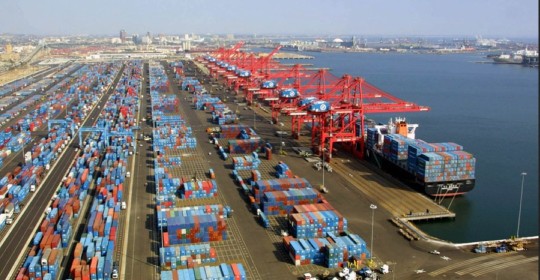
Labor fight at West Coast ports comes to an end — for now
Last night, the owners of 29 West coast shipping terminals and the union of dockworkers that staff them reached a tentative deal for a new contract, after nine months of negotiations that culminated in four days of meetings with two cabinet secretaries. The ports can now resume normal operations — or at least start working on the backlog of stalled goods that have been waiting to move in and out.
Retailers, manufacturers and agricultural exporters had been infuriated by the delay, as work slowdowns and lockouts created a massive traffic jam on the docks, and greeted the announcement with relief. But their responses also came with heavy sighs and wagging fingers, signifying a lasting exasperation over the disruption to business as usual — and worry about whether this might mark the end of these confrontations.
“As we welcome today’s news, we must dedicate ourselves to finding a new way to ensure that this nightmare scenario is not repeated again,” said National Retail Federation president Matthew Shay. “If we are to truly have modern international trade, supply chain and transportation systems, we must develop a better process for contract negotiations moving forward.”
Now, everyone involved is asking: Is there some way to change the process so that this kind of thing doesn’t happen in the future?
The same question came up the last time the east coast ports came to an agreement with their longshore union, in 2012, when a shutdownwas narrowly averted. Although the east coast dockworkers haven’t actually gone on strike since 1977, periodic contract negotiations cause widespread unease among shippers, who are looking for some sort of assurance that commerce wouldn’t grind to a halt. The process has changed over the decades — now the ports negotiate all together rather than one by one. But while that prevents smaller-scale strikes, it raises the stakes of coast-wide negotiations that could shut them all down at once.
The problem is, the threat of business interruption is the only thing that gives a union leverage, so it’s unlikely workers would agree to significant changes. Unlike most unions, the Longshoremen have only become more powerful over the last few decades of increasing trade, since they now control the movement of a larger percentage of the economy — if they can maintain it. And indeed, when the east coast union leader Harold Daggett was asked last year whether he would be open to tweaking the negotiation process, the answer was a firm “no.”
Thus, the only check on supply chain devastation is the threat of executive branch intervention under the Taft-Hartley Act of 1947. President Obama raised that specter by sending Labor Secretary Tom Perez and Commerce Secretary Penny Pritzker to mediate the dispute. But actually ordering the ports back to work is politically dicey, with Obama reluctant to antagonize union allies, and a lot of economic damage can happen before any president takes that step.
Besides, as I described last week, there’s a lot more going wrong with the ports than simply labor relations: Rising container trade and evolving shipping alliances have snarled logistical procedures, requiring substantial and time-consuming investment in infrastructure to fix. And industry groups recognize that too.
“Today’s slowdown on the West Coast may be the result of contract negotiations, but the impact it had on retailers provides a window into the future as increasing volumes and complexity will create similar backups, delays, higher costs and lost productivity,” said Kelly Kolb, vice president for government relations of the Retail Industry Leaders Association.
Read more st: http://www.washingtonpost.com/blogs/wonkblog/wp/2015/02/21/labor-fight-at-west-coast-ports-comes-to-an-end-for-now/
Leave a reply →
